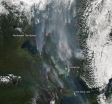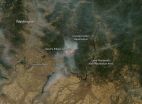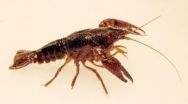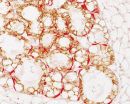(Press-News.org) Once Super Typhoon Genevieve has now been downgraded to a tropical storm. The storm is located approximately 819 nautical miles west-northwest of Midway Island. It is currently tracking northwestward at 8 knots per hour over the past six hours. Maximum significant wave height is 32 feet. Maximum sustained winds 70 knots gusting to 85 knots, with winds of 34 knots or higher occur within 80 to 105 miles of the cente,r and winds of 64 knots or higher occur within 15 miles of the center. No landmasses are currently threatened by this storm.
Genevieve is moving northwest and has continued to weaken. Unfavorable environmental factors has caused a rapid weakening over the past 12 hours. The storm will dissipate within 2-3 days, far southeast of the Aleutian islands.
INFORMATION:
Text credit: Lynn Jenner
NASA's Goddard Space Flight Center
Genevieve Downgraded to a tropical storm
2014-08-11
ELSE PRESS RELEASES FROM THIS DATE:
Southfork and Staley Complex fires in Oregon
2014-08-11
The Southfork Complex fire began with a lightning strike on July 31, 2014. The complex of Murderers Creek South fire and the Buck Fork fire is located 20 miles southwest of John Day, Oregon and has affected 62,476 acres to date. The fire area experienced a shift in direction of the prevailing winds Sunday. There were short up-slope, up-canyon runs. At present there are 798 personnel fighting this fire complex.
Projected outlook for this fire complex in the next twelve hours sees continued fire spread to to the north toward Dayville, Oregon as well as continued fire ...
Devil's Elbow Complex in Washington state
2014-08-11
The Devil's Elbow Complex is four wildfires that are located on the Colville Indian Reservation in northeastern Washington. They were detected on August 3, but were likely ignited by lightning that passed through the area on August 2.
Three fires are in the San Poil River Valley, approximately 10-12 miles north of the town of Keller, WA. These are the Cub Creek Fire (165), the Central Peak Fire (160), and the Deadhorse Fire (164). They are burning timber, grass, brush, litter, and heavy slash that resulted from a local wind storm two years ago. The terrain is very steep ...
Synthetic molecule makes cancer self-destruct
2014-08-11
Researchers from The University of Texas at Austin and five other institutions have created a molecule that can cause cancer cells to self-destruct by ferrying sodium and chloride ions into the cancer cells.
These synthetic ion transporters, described this week in the journal Nature Chemistry, confirm a two-decades-old hypothesis that could point the way to new anticancer drugs while also benefitting patients with cystic fibrosis.
Synthetic ion transporters have been created before, but this is the first time researchers have shown them working in a real biological ...
NIST therapy for ultraviolet laser beams: Hydrogen-treated fibers
2014-08-11
To make a better optical fiber for transmitting laser beams, the first idea that comes to mind is probably not a nice long hydrogen bath.
And yet, scientists have known for years that hydrogen can alter the performance of optical fibers, which are often used to transmit or even generate laser light in optical devices. Researchers at the National Institute of Standards and Technology (NIST) have put this hydrogen "cure" to practical use, making optical fibers that transmit stable, high-power ultraviolet laser light for hundreds of hours. NIST scientists expect these hydrogen-treated ...
Stanford researchers uncover cancer-causing mechanism behind powerful human oncogene
2014-08-11
A protein present at high levels in more than half of all human cancers drives cell growth by blocking the expression of just a handful of genes involved in DNA packaging and cell death, according to a new study by researchers at the Stanford University School of Medicine.
The researchers found that the protein, called Myc, works through a tiny regulatory molecule called a microRNA to suppress the genes' expression. It marks the first time that a subset of Myc-controlled genes has been identified as critical players in the protein's cancer-causing function, and suggests ...
Blood cells are a new and unexpected source of neurons in crayfish
2014-08-11
Researchers have strived for years to determine how neurons are produced and integrated into the brain throughout adult life. In an intriguing twist, scientists reporting in the August 11 issue of the Cell Press journal Developmental Cell provide evidence that adult-born neurons are derived from a special type of circulating blood cell produced by the immune system. The findings—which were made in crayfish—suggest that the immune system may contribute to the development of the unknown role of certain brain diseases in the development of brain and other tissues.
In many ...
How breast cancer usurps the powers of mammary stem cells
2014-08-11
During pregnancy, certain hormones trigger specialized mammary stem cells to create milk-producing cells essential to lactation. Scientists at the University of California, San Diego School of Medicine and Moores Cancer Center have found that mammary stem cells associated with the pregnant mammary gland are related to stem cells found in breast cancer.
Writing in the August 11, 2014 issue of Developmental Cell, David A. Cheresh, PhD, Distinguished Professor of Pathology and vice-chair for research and development, Jay Desgrosellier, PhD, assistant professor of pathology ...
Malaria medicine chloroquine inhibits tumor growth and metastases
2014-08-11
A recent study by investigators at VIB and KU Leuven has demonstrated that chloroquine also normalizes the abnormal blood vessels in tumors. This blood vessel normalization results in an increased barrier function on the one hand -- thereby blocking cancer cell dissemination and metastasis -- and in enhanced tumor perfusion on the other hand, which increases the response of the tumor to chemotherapy.
The anti-cancer effect of the antimalarial agent chloroquine when combined with conventional chemotherapy has been well documented in experimental animal models. To date, ...
Climate change negatively impacting Great Lakes, GVSU researcher says
2014-08-11
MUSKEGON, Mich. -- Climate change is having a direct negative effect on the Great Lakes, including impacts to recreational value, drinking water potential, and becoming more suited to invasive species and infectious pathogens, according to a Grand Valley State University researcher.
The impact of climate change on the Great Lakes, as well as other natural resources in the United States, was explored in the report "Science, Education, and Outreach Roadmap for Natural Resources," recently released by the Association of Public and Land-grant Universities. Kevin Strychar, ...
CRI scientists pinpoint gene likely to promote childhood cancers
2014-08-11
DALLAS – Aug. 11, 2014 – Researchers at the Children’s Medical Center Research Institute at UT Southwestern (CRI) have identified a gene that contributes to the development of several childhood cancers, in a study conducted with mice designed to model the cancers. If the findings prove to be applicable to humans, the research could lead to new strategies for targeting certain childhood cancers at a molecular level. The study was published today in the journal Cancer Cell.
“We and others have found that Lin28b – a gene that is normally turned on in fetal but not adult ...







